The spectacular Red Bauhinia , ( Bauhinia galpinii ) is adding it's warm colour to the winter cold here in Sydney. This is a large shrub or small tree, growing around 3 to 6 metres high. It is native to Africa and thrives in temperate to warm climates. Red or orange flowers ( depending on the variety ) cover the tree, but the green lobed foliage is also very attractive, being similar in shape to a Camel's foot. Birds are attracted to the flowers for the nectar, so this is a good plant for wildlife lovers. This tree was growing in one of Sydney's local gardens.
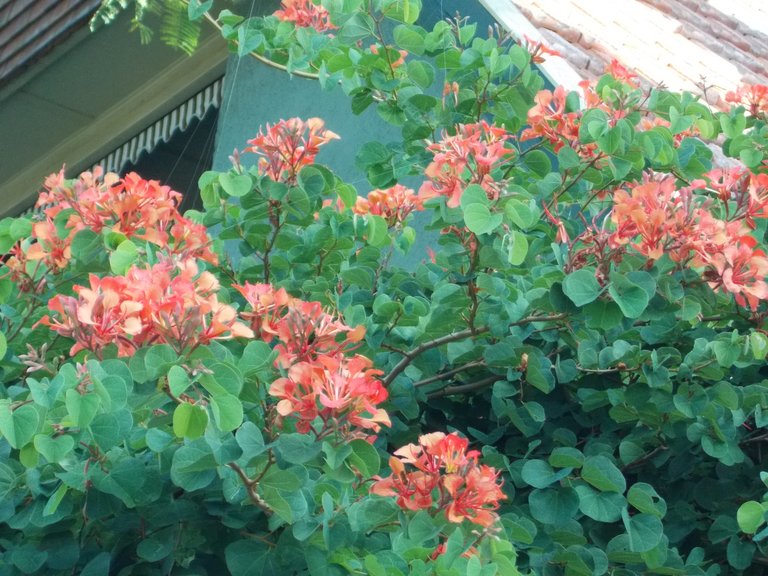
Beautifull photography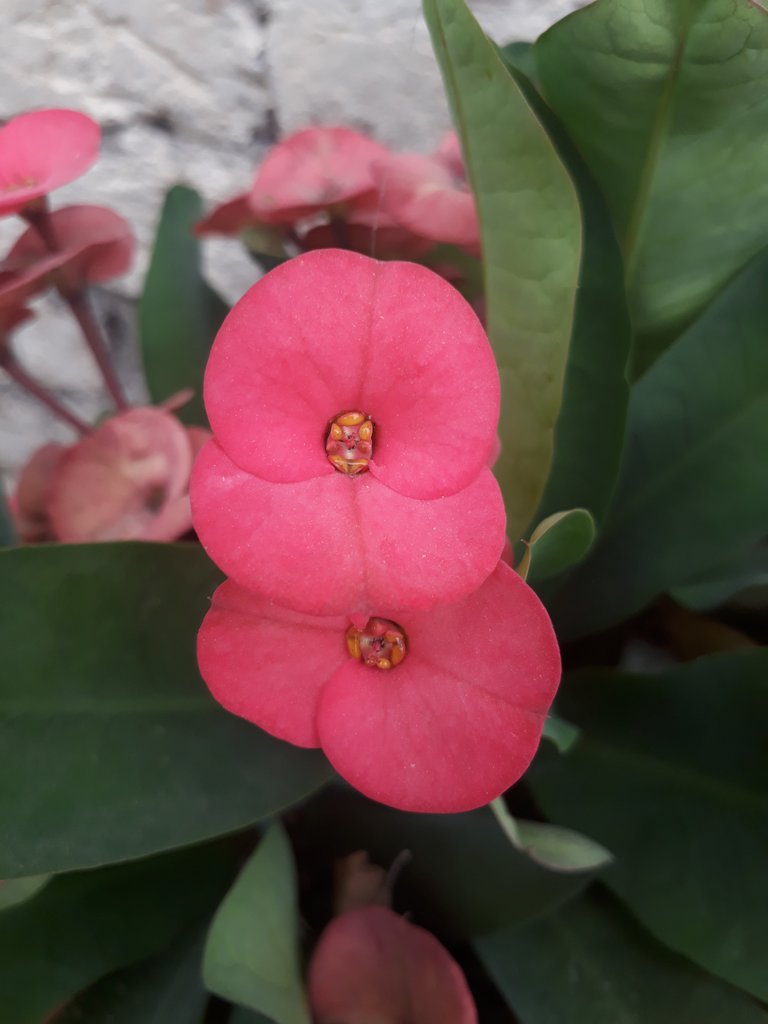
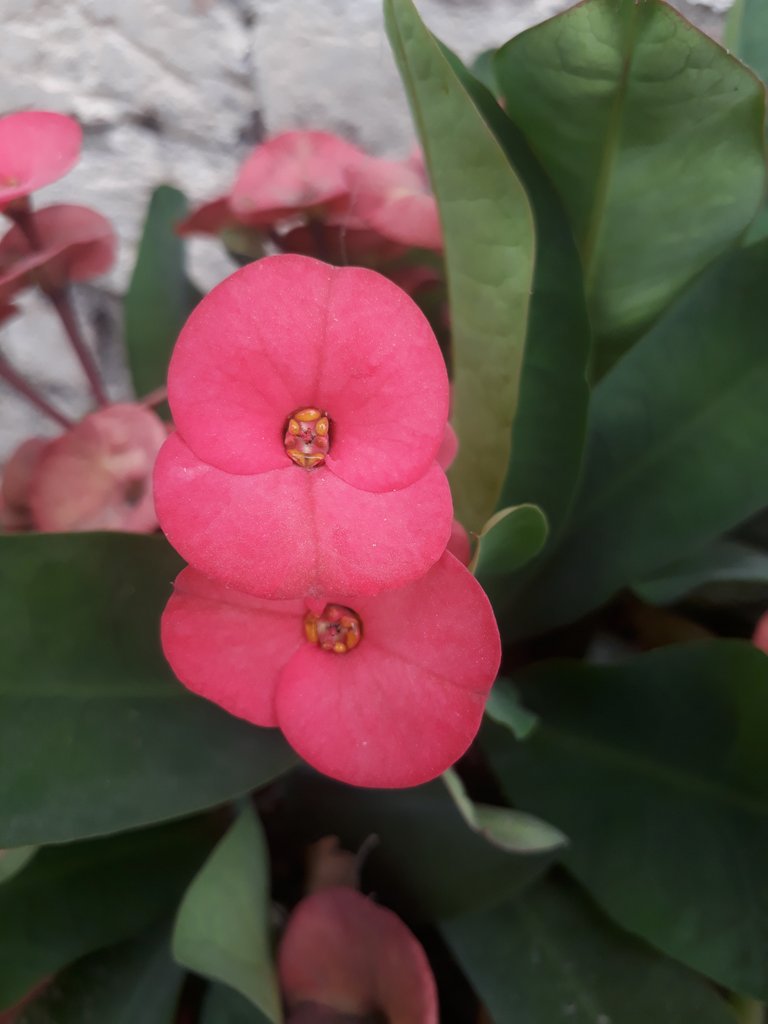
I also take these picture a few days ago
Hope you like it.
Yes, very nice. It looks like Euphorbia, does it have thorns?
Yes it have thorns.
@ctrl-alt-nwo, This is wanna most impressive plant introduction my friend. Most fabulous flowers indeed those plant. I prefer to read your another gardening post and I add some more information through another web.
In its wild state this medium to large shrub behaves more as a climber, clambering through the trees and shrubs of the dense thicket vegetation in which it occurs. It doesn't have to be grown in this fashion in your garden and with just a little pruning and training it can easily be trained into an attractive small tree or large garden shrub. Alternatively it can be encouraged in its clambering habit to cover pergolas or other structures and offer evergreen shade in your garden.
As the name suggests, anyone could be forgiven for thinking that this plant comes from the Cape. In actual fact it is named after the De Kaap valley, south of Nelspruit in Mpumalanga in the northeastern region of South Africa. It is much more widespread, however, and can be found right across the moister bushveld areas of the country.
Thanks for your valuable content.
Source: http://pza.sanbi.org/bauhinia-galpinii
Congrats, you got the Silly Sausage Award for your great comment. Well done.
Thanks your consider to mine.
A shrubby plant that often climbs into surrounding trees and reaches up to 5 m or more in height. Its younger branches are finely hairy while the older stems quickly become hairless. Its broad leaves (2-7 cm long) have two rounded lobes at the tip and are often folded lengthwise. Its orange to dark red flowers have five have five large petals (2.5-5 cm long) with narrow bases and broad rounded tips. Its large elongated pods (8-13 cm long and 18-28 mm wide) turn dark brown in colour as they mature.
The younger branches are finely hairy (i.e. puberulous) while but they quickly become hairless (i.e. glabrous). The alternately arranged leaves are borne on short stalks (i.e. petioles) 5-23 mm long. They are often folded lengthwise and are butterfly-like in appearance. Their upper surfaces are hairless (i.e. glabrous), while their undersides are sparsely hairy (i.e. puberulent).
Flowering branches and flower stalks (i.e. pedicels) are densely covered with tiny brownish coloured hairs (i.e. they are pubescent). The individual flowers are borne on stalks only 2-5 mm long, but the base of each flower forms a narrow stalk-like tube (i.e. hypanthium) 17-32 mm long that is obscurely to conspicuously ribbed lengthwise.
Source
Congrats, you won the Fav. comment Award for your great comment. Shared with one other.
Thank you! I have posted Lantana flowers, please have a look at my blog. :)
A shrubby plant that often climbs into surrounding trees and reaches up to 5 m or more in height. Its younger branches are finely hairy while the older stems quickly become hairless. Its broad leaves (2-7 cm long have two common names.

Also known as: red bauhinia, African orchid tree, African plume, butterfly bush, dwarf orchid tree, lowveld bauhinia, orchid tree, pride of De Kaap, red orchid tree.
KNOWN DISTRIBUTION
Occasionally naturalised in the Moreton district in south-eastern Queensland. Also recorded on a couple of occasions in central Queensland.
HABITAT
A weed of roadsides, disturbed sites, waste areas, old gardens, urban bushland, coastal environs, gullies, riparian vegetation, open woodlands and forest margins.
HABIT
A shrubby plant usually growing 1-4 m tall in cultivation. However, it often climbs into surrounding trees and reaches up to 5 m or more in height when growing in natural vegetation (i.e. it is a scandent shrub).
Thanks @ctrl-alt-nwo for sharing this post. 🤗💚
magoo-2 found a series of multi accounts of a same owner is following your articles to cheat your generous rewards.
magoo-2 found these accounts are suspicious & can be multi accounts of a single owner. Conclusion is based on last 30 days transactions:
@stardivine @invinciblelight @lovehaswon
magoo-2
Check our latest multi comment spam update report
Red bauhinia is a dense, semi-climbing, evergreen shrub with deeply-cleft, 2-lobed leaves that resemble the hooves of cattle (Fig. 1). The flowers of this sprawling plant are orchid-like in appearance, brick-red in color, and borne in few flowered racemes. The 1 1/2-inch-wide flowers of red bauhinia occur in the spring and summer and put on quite a show if the plant is trained on a trellis. The fruits are 5-inch-long pods that appear in the late summer, and these may be a litter problem.
Red bauhinia is nice in the landscape as an espalier, specimen, border, ground cover, and container plant. It climbs a fence nicely, producing most of the flowers near the top. It is a bit asymmetrical, perhaps even unkempt looking, making it best suited for the large-scale landscape planting.
Red bauhinia requires a location in the landscape in which it receives full sun and grows best on a well-drained, sandy loam soil. It often suffers from a deficiency of micronutrients in soil with a pH above 7. Preventive fertilizer applications help keep the foliage green. This plant requires little maintenance once it is established but may need early spring pruning or shaping for growth control.
http://edis.ifas.ufl.edu/fp061
Bauhinia galpinii, also named the African Plume, the Red Orchid Tree or the Pride of De Kaap, is named after the De Kaap valley, South of Nelspruit in Mpumalanga in the Northeastern region of South Africa. The species epithet "galpinii" honors Ernest Galpin (1858-1941), a South African plant collector. It is a Southern Africa evergreen to semi-evergreen sprawling shrub, up to 10 feet tall and 15 feet sprawl. In its wild state this medium to large shrub behaves more as a climber, clambering through the trees and shrubs of the dense thicket vegetation in which it occurs. It can be encouraged in its clambering habit to cover pergolas or other structures and offer evergreen shade in your garden. It doesn't have to be grown in this fashion in your garden and with just a little pruning and training it can easily be trained into an attractive small tree or large garden shrub. It produces its brick red flowers, 2.5 inches in diameter, for a long period from Spring to Fall. The leaves are two-lobed, grayish-green, resembling a butterfly in shape, and 2-3 cm long. The pods are straight, dark brown, 10-15 cm long and 2-3 cm broad. Hardiness zones 9-11, (-5°C/25°F, 5°C/40°F) in Winter. It is hardy to drought and moderate frost, but may need protection from frost in the first two or three years after planting. Use sandy well drained potting soil. The pride of De Kaap is easy to cultivate and requires little attention once established. Grow in full sun and procure average water.
http://www.rarexoticseeds.com/en/bauhinia-galpinii-seeds-red-orchid-tree-seeds.html
When in bloom, the nasturium-bauhinia looks like a reddish-orange bougainvillea from a distance due to its habit and profuse flowers. A semi-deciduous tree native to southeastern Africa, it grows upright, but has drooping, spreading branches that flop to the ground or on to nearby plants.
The leaves are rounded and divided into two lobes like other Bauhinia. They are a light to medium green and shed during the cool or lightly frosty winter season. The five-petaled flowers bloom most heavily in spring, but recur sporadically through summer and early autumn. Each blossom is red-orange to salmon with five claw-like petals. Hummingbirds and butterflies visit these blooms; this only occasionally leads to seed pod production.
Grow nasturium-bauhinia in full to partial sun and fertile, well-drained soil. It is fairly drought tolerant once established. Plant in acid to neutral soils for best health. Alkaline soils can cause nutrient deficiencies and leaf yellowing. This tropical small tree is best grown in areas where summers are moist and winters cool and dry. It will be killed back to the roots by winter cold in USDA zone 8 but will rejuvenate each spring. These plants also maintain a more shrubby habit.
http://www.learn2grow.com/plants/bauhinia-galpinii/
Red bauhinia (Bauhinia galpinii)
Common names
Orgueil du Cap, bahninia rouge, bois de bœuf rouge, nasturtium bauhinia, pride of de Kaap, red bauhinia, red butterfly rree, sabot bœuf rouge, Pride of the Cape
Species
Bauhinia galpinii N.E. Br. [Fabaceae]
Feed categories
Legume forages Forage plants
Related feed(s)
Description
Dense bush or rambler up to 1.5 m high. The leaves are two-lobed, resembling a butterfly in shape, and 2-3 cm long. It bears a profusion of red flowers about 2-5 cm in diameter. The pods are straight, dark brown, 10-15 cm long and 2-3 cm broad. Usually occurs in sheltered areas along rivers and gorges. Cannot withstand frost.
https://steemit.com/bauhinia/@ctrl-alt-nwo/red-bauhinia-a-warm-colour-during-winter
Red Bauhinia
A very common tree around the Highlands, Bauhinia seems to grow in just about any soil type and can get to about 500mm diameter and up to 10 metres high. It's often left behind when clearing grazing country as it makes a good shade tree and can be cut down for fodder during dry times.
It is not unusual these days to see Red Bauhinia growing among swathes of dead trees giving the impression that it is the only species to have survived the drought. The reality however, is that Bauhinia is one of the few species that is unaffected by the pelletised herbicide "Grassland", that is dropped from planes to kill off large areas of trees quickly and easily.
A 200mm cross section showing the 'ebony' heartwood. Like spalting, this is just a stage prior to rotting which makes it difficult to stabilise for turning.
https://steemit.com/bauhinia/@ctrl-alt-nwo/red-bauhinia-a-warm-colour-during-winter
Red Orchid Tree
Common name: Red Orchid Tree, Red Bauhinia, Pride of the Cape, African Plume, Nasturtium Bauhinia
Botanical name: Bauhinia galpinii N.E.Br. Bauhinia galpinii Family: Caesalpiniaceae (Gulmohar family)
This beautiful shrub comes from South Africa. In its wild state this medium to large shrub behaves more as a climber, clambering through the trees and shrubs of the dense thicket vegetation in which it occurs. It doesn't have to be grown in this fashion in your garden and with just a little pruning and training it can easily be trained into an attractive small tree or large garden shrub. Alternatively it can be encouraged in its clambering habit to cover structures. The leaves are deciduous. They are divided into two lobes, resembling the footprint of a cloven hoof. From mid-summer through mid-autumn it bears a heavy crop of brick-red to orangey orchid-like flowers. This species requires space, even if it is to be regularly pruned, and is not suitable for the small garden.
http://www.flowersofindia.net/catalog/slides/Red%20Orchid%20Tree.html
Red Bauhinia
Family: Fabaceae (fab-AY-see-ee) (Info)
Genus: Bauhinia (baw-HIN-ee-uh) (Info)
Species: galpinii (gal-PIN-ee-eye) (Info)
Synonym: Bauhinia punctata
Synonym: Perlebia galpinii
https://davesgarden.com/guides/pf/go/58957/#b
Red Orchid Tree, Pride of de Kaap, Red Bauhinia, African Plume
Bauhinia galpinii
Fabaceae
2-3" wide reddish orange to brick-red orchid-like blossoms are produced in clusters from summer and into fall are held against the blue-green bi-lobed foliage. The Red Orchid Tree is a naturally sprawling medium to large evergreen to deciduous tropical shrub and can easily be trained into a small tree, pruned into a shrub form, or even as a vine over a small arbor in mild winter climates. This beautiful Bauhinia can also be enjoyed as a container plant or espalier. The flowers attract a variety of pollinators including butterflies, bees, and hummingbirds. A South African species, Pride of de Kaap is drought resistant once well established but will flower best with average moisture, a well-drained, fertile soil, and full sunlight. Wind tolerant as well.
The Red Orchid Tree is considered hardy into zone 9 but may suffer die back and will at least defoliate at temperatures below 20-25oF and is often grown as a die-back perennial outside of zone 9B,10, and 11. We know of plants that have reliably returned in zone 8B where given protection. Plant in late spring or early summer once danger of frost has past to maximize establishment before winter sets in or grow it as a container plant for the first few years to help improve its chance of survival in areas where hardiness is questionable. If overwintering indoors provide as much direct sunlight as possible and allow the soil to become slightly dry between waterings.
Bauhinia galpinii is often listed as fragrant, though it is not something that we have noticed to date. This popular plant is a.k.a Nasturtium Bauhinia. Considered suitable for xeriscaping.
Grows To: 6-10'H x 10-20'W and larger in mild winter climates. 3-4'H x 4-5'W as a die-back perennial or container plant.
https://almostedenplants.com/shopping/products/11012-red-orchid-tree-pride-of-de-kaap-red-bauhinia-african-plume/
Hi @ctrl-alt-nwo
Love to see your one more entry about the lovely flowering plants which attract the wildlife lovers. Red Bauhinia or Bauhinia galpinii is amazing addition here in steemit through your blog. My Appreciation and Support always for you for your impressive role and effort for making people aware about such kind of informative topics. Hats off my friend. Take care. Here I am sharing some pictures of Bauhinia which I collect from Google you can see reddish flowers with five petals that have narrow bases and rounded tips and looking so awesome and attractive.
Source
Source
Source
I Love Nature and Natural Scenes.
This is my grandfather's flower, I think it looks like a flower in your photo.


in my countryside , we call this flower;'' cow's foot flower''
Yes, it is another variety of the Bauhinia.
A shrubby plant that often climbs into surrounding trees and reaches up to 5 m or more in height. Its younger branches are finely hairy while the older stems quickly become hairless. Its broad leaves (2-7 cm long) have two rounded lobes at the tip and are often folded lengthwise. Its orange to dark red flowers have five have five large petals (2.5-5 cm long) with narrow bases and broad rounded tips. Its large elongated pods (8-13 cm long and 18-28 mm wide) turn dark brown in colour as they mature.
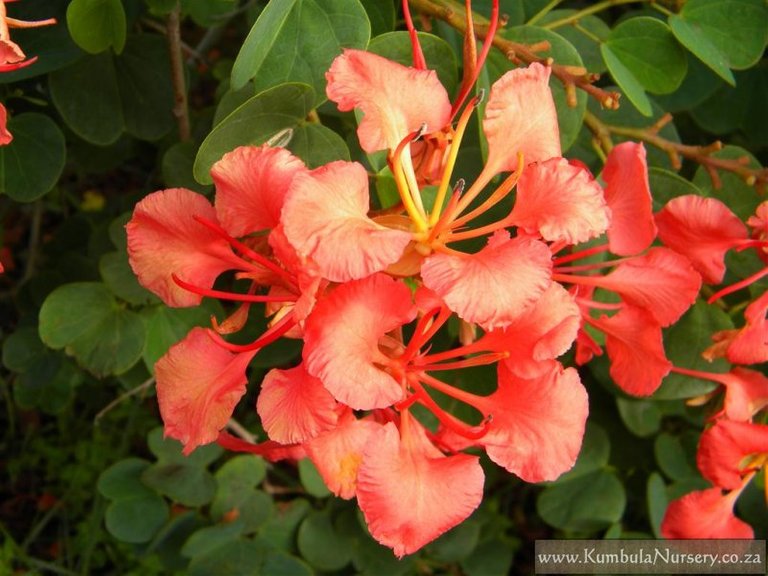
This is very beautiful garden and beautiful photography. .it is very looking for this red bauhinia.
 Thanks @ctrl-alt-nwo
Thanks @ctrl-alt-nwo
Have a great day
Red Bauhinia is a species of shrub in the family Fabaceae. The flower looks very beautiful.
image source
The plant is evergreen and growing season in summer. The flowers has variously known in worldwide like it's popular name is "Pride of De Kaap", Orchid tree, Nasturtium Bauhinia, African Plume, Red Orchid Bush and more names.
image source
Thanks sir @ctrl-alt-nwo for always sharing beautiful flowers.
That is a amazing trees and really beautiful flowers. the beat of garden.


Thanks for the information.
100% like and resteem
Wonderful Australia Red Bauhinia Plant and so Fantastic. this is valuable article.
@ctrl-alt-nwo
Happy to see you once again with an amazing Flower tree..
Red Bauhinia:
2-3" wide reddish orange to brick-red orchid-like blossoms are produced in clusters from summer and into fall are held against the blue-green bi-lobed foliage. The Red Orchid Tree is a naturally sprawling medium to large evergreen to deciduous tropical shrub and can easily be trained into a small tree, pruned into a shrub form, or even as a vine over a small arbor in mild winter climates. This beautiful Bauhinia can also be enjoyed as a container plant or espalier.
Bauhinia galpinii is often listed as fragrant, though it is not something that we have noticed to date. This popular plant is a.k.a Nasturtium Bauhinia. Considered suitable for xeriscaping.
Grows To: 6-10'H x 10-20'W and larger in mild winter climates. 3-4'H x 4-5'W as a die-back perennial or container plant.
.jpeg) 
COMMON NAMES
Also known as: red bauhinia, African orchid tree, African plume, butterfly bush, dwarf orchid tree, lowveld bauhinia, orchid tree, pride of De Kaap, red orchid trees.... Occasionally naturalised in the Moreton district in south-eastern Queensland. Also recorded on a couple of occasions in central Queensland.
A shrubby plant that often climbs into surrounding trees and reaches up to 5 m or more in height. Its younger branches are finely hairy while the older stems quickly become hairless. Its broad leaves (2-7 cm long) have two rounded lobes at the tip and are often folded lengthwise. Its orange to dark red flowers have five have five large petals (2.5-5 cm long) with narrow bases and broad rounded tips. Its large elongated pods (8-13 cm long and 18-28 mm wide) turn dark brown in colour as they mature.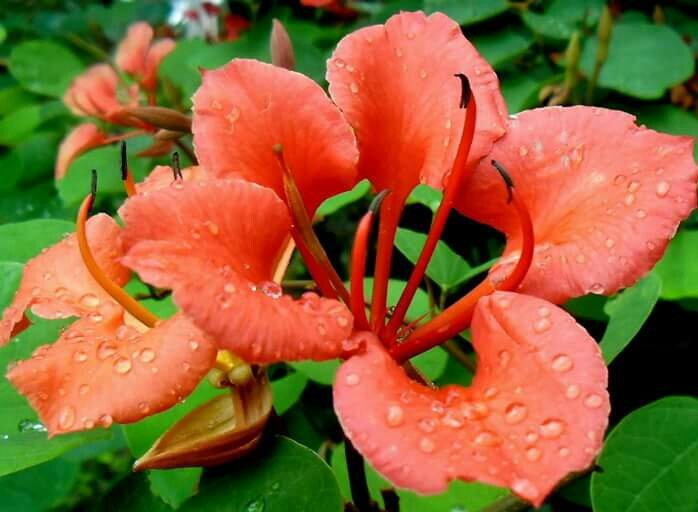 COMMON NAMES
COMMON NAMES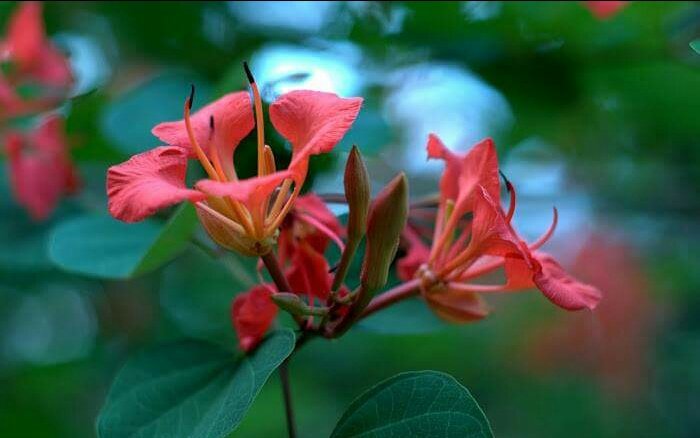 a weed of roadsides, disturbed sites, waste areas, old gardens, urban bushland, coastal environs, gullies, riparian vegetation, open woodlands and forest margins.A shrubby plant usually growing 1-4 m tall in cultivation. However, it often climbs into surrounding trees and reaches up to 5 m or more in height when growing in natural vegetation.
a weed of roadsides, disturbed sites, waste areas, old gardens, urban bushland, coastal environs, gullies, riparian vegetation, open woodlands and forest margins.A shrubby plant usually growing 1-4 m tall in cultivation. However, it often climbs into surrounding trees and reaches up to 5 m or more in height when growing in natural vegetation. 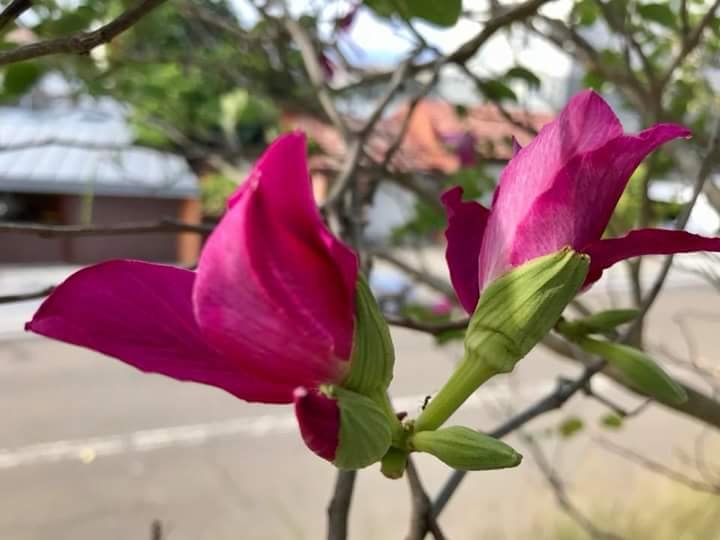 The younger branches are finely hairy (i.e. puberulous) while but they quickly become hairless (i.e. glabrous). The alternately arranged leaves are borne on short stalks (i.e. petioles) 5-23 mm long. These leaves (2-7 cm long and up to 7 cm wide) are broad with entire margins and two rounded lobes at the tip (i.e. they are bi-lobed). They are often folded lengthwise and are butterfly-like in appearance. Their upper surfaces are hairless (i.e. glabrous), while their undersides are sparsely hairy (i.e. puberulent)
The younger branches are finely hairy (i.e. puberulous) while but they quickly become hairless (i.e. glabrous). The alternately arranged leaves are borne on short stalks (i.e. petioles) 5-23 mm long. These leaves (2-7 cm long and up to 7 cm wide) are broad with entire margins and two rounded lobes at the tip (i.e. they are bi-lobed). They are often folded lengthwise and are butterfly-like in appearance. Their upper surfaces are hairless (i.e. glabrous), while their undersides are sparsely hairy (i.e. puberulent) 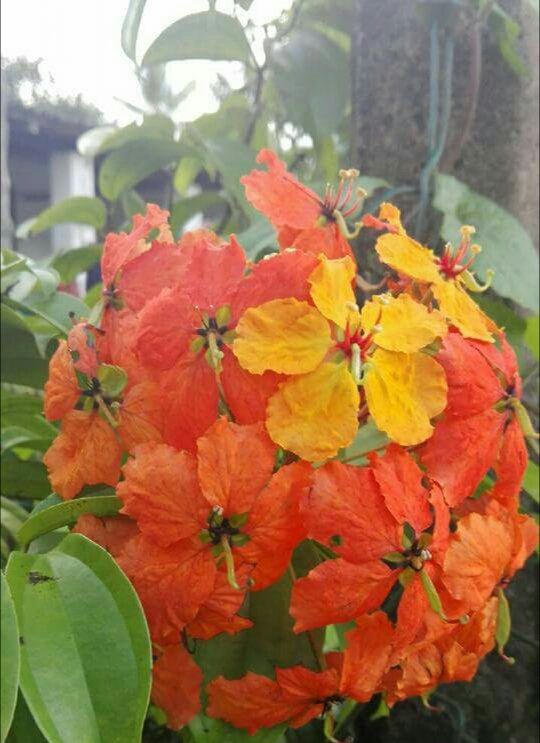
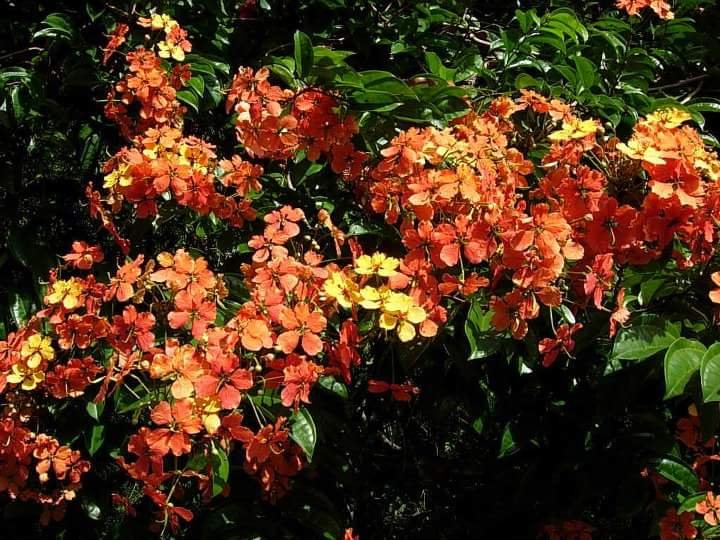 This species reproduces by seed and may eventually form large and dense thickets over time.It is usually spread into natural areas in dumped garden waste, but its seeds may also be dispersed by water, mowers and slashers.thanks to sharing for your again fantastic post of gorgeous flower.. very well done.. my dear friend @ctrl-alt-nwo
This species reproduces by seed and may eventually form large and dense thickets over time.It is usually spread into natural areas in dumped garden waste, but its seeds may also be dispersed by water, mowers and slashers.thanks to sharing for your again fantastic post of gorgeous flower.. very well done.. my dear friend @ctrl-alt-nwo
Also known as: red bauhinia, African orchid tree, African plume, butterfly bush, dwarf orchid tree, lowveld bauhinia, orchid tree, pride of De Kaap, red orchid trees.... Occasionally naturalised in the Moreton district in south-eastern Queensland. Also recorded on a couple of occasions in central Queensland.
The flowers are arranged in slightly elongated clusters in the leaf forks (i.e. axillary racemes) near the tips of the branches, each cluster containing 2-10 flowers. Flowering branches and flower stalks (i.e. pedicels) are densely covered with tiny brownish coloured hairs (i.e. they are pubescent). The individual flowers are borne on stalks only 2-5 mm long, but the base of each flower forms a narrow stalk-like tube (i.e. hypanthium) 17-32 mm long that is obscurely to conspicuously ribbed lengthwise. These flowers have five brownish coloured sepals (19-28 mm long) that are fused together and split lengthwise when the flower opens. They have five large petals (2.5-5 cm long) that vary in colour from orange to scarlet, bright red, crimson, brick red or dark red.
magoo-2 found a series of multi accounts of a same owner is following your articles to cheat your generous rewards.
magoo-2 found these accounts are suspicious & can be multi accounts of a single owner. Conclusion is based on last 30 days transactions:
@timuann @rahulsen
magoo-2
Check our latest multi comment spam update report
i think that,you not doing your work properly this platform.because always seen you comment doing any other steemian sms.its not your work this community.you are really fake.this post not comment rahulsen. but you telling my account and rahul sen account same.its other stermian account.i know you got for upvoting doing this fake same comment any steemians post and comment.because you are fake, so,you not got support steemians.your work really very bad. this is a rubbish.. @magoo-2
G’day mate! and I Upvoted you :) !
:
“Unrequited love is a billion times less intolerable than unrequited hate.” ====> Mokokoma Mokhonoana
Thanks buddy !
I thought that flowers are leaves of the tree! It's amazing and never saw it here!@ctrl-alt-nwo,
Cheers~
Beautiful plant..looking like spring is there.
It's still winter here, Spring in about 6 weeks.
A shrubby plant that often climbs into surrounding trees and reaches up to 5 m or more in height. Its younger branches are finely hairy while the older stems quickly become hairless. Its broad leaves (2-7 cm long) have two rounded lobes at the tip and are often folded lengthwise. Its orange to dark red flowers have five have five large petals (2.5-5 cm long) with narrow bases and broad rounded tips. Its large elongated pods (8-13 cm long and 18-28 mm wide) turn dark brown in colour as they mature.
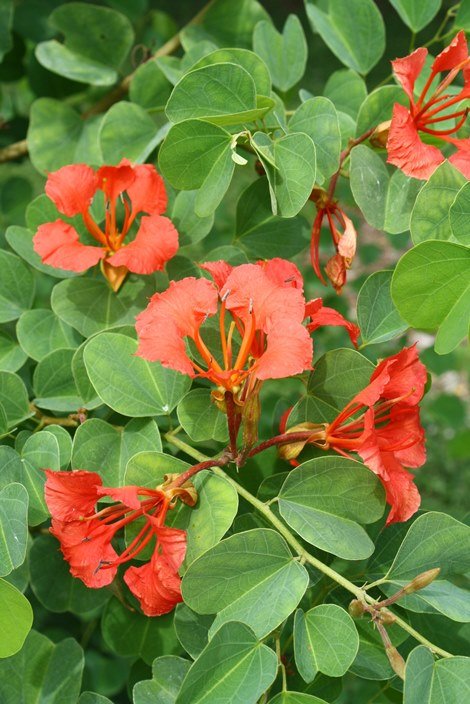
Outdoor Light: Full sun, Mostly sunny
Indoor Light: Direct sunlight
pH Range: Acidic, Mildly Acidic, Neutral, Mildly Alkaline
Soil & Moisture: Well-drained, fertile soils with average moisture during establishment. Good drought resistance once well-established.
Salt Tolerance: Moderate soil tolerance, Poor aerosol salt tolerance
Deer Resistance: Moderate to High
Native To / Origin: South Africa - North Eastern, Zimbabwe, Mozambique, Swaziland
.jpeg)

. This species reproduces by seed and may eventually form large and dense thickets over time.It is usually spread into natural areas in dumped garden waste, but its seeds may also be dispersed by water, mowers and slashers.thanks to sharing for your again fantastic post of gorgeous flower.. very well done.. my dear friend @ctrl-alt-nwo
So beautiful garden, thanks for sharing
Resteem
This is lOoking so cool flowers.
Red bauhinia (Bauhinia galpinii) is relatively similar to closely related species such as pink bauhinia (Bauhinia monandra), butterfly tree (Bauhinia variegata) and purple bauhinia (Bauhinia purpurea). These species can be distinguished by the following differences: red bauhinia (Bauhinia galpinii ) is a large spreading shrub, sometimes climbing over other vegetation (i.e. a scandent chrub), with relatively small leaves (less than 10 cm wide). Its flowers vary from orange to scarlet or dark red and have three fertile stamens.pink bauhinia (Bauhinia monandra) is a small upright tree with relatively large leaves (up to 20 cm wide). Its flowers are pale pink or whitish with darker pink or reddish-purple markings and have a single fertile stamen.butterfly tree (Bauhinia variegata) is a small upright tree with relatively large leaves (up to 15 cm wide). Its flowers vary from entirely white to various shades of pink or purple with darker pink or reddish-purple markings and have five fertile stamens.purple bauhinia (Bauhinia purpurea) is a small upright tree with relatively large leaves (up to 20 cm wide). Its flowers vary from pale purple to bright pinkish-purple and have three fertile stamens.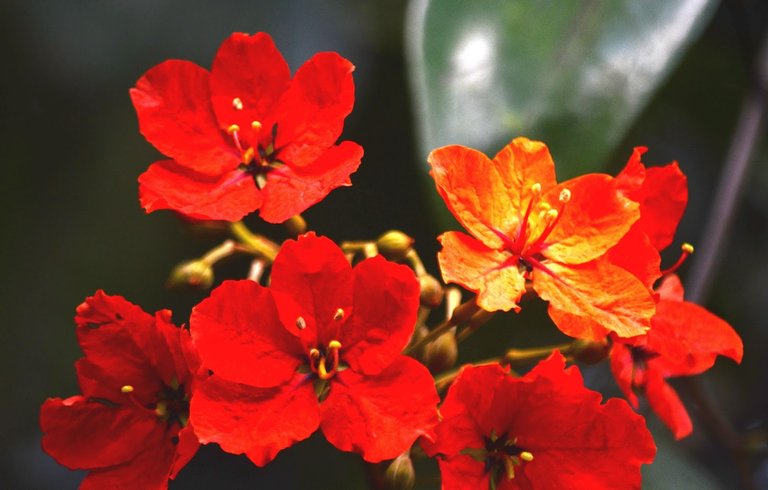
Why do people give each other flowers? To celebrate various important occasions, they're killing living creatures? Why restrict it to plants? "Sweetheart, let's make up. Have this deceased squirrel
Funny girl !
By the time one is eighty, it is said, there is no longer a tug of war in the garden with the May flowers hauling like mad against the claims of the other months. All is at last in balance and all is serene. The gardener is usually dead, of course.
When it doesn't seem quite right to send a bouquet, send a funny flower quote instead. They are fast and simple. It's easy to share them quickly.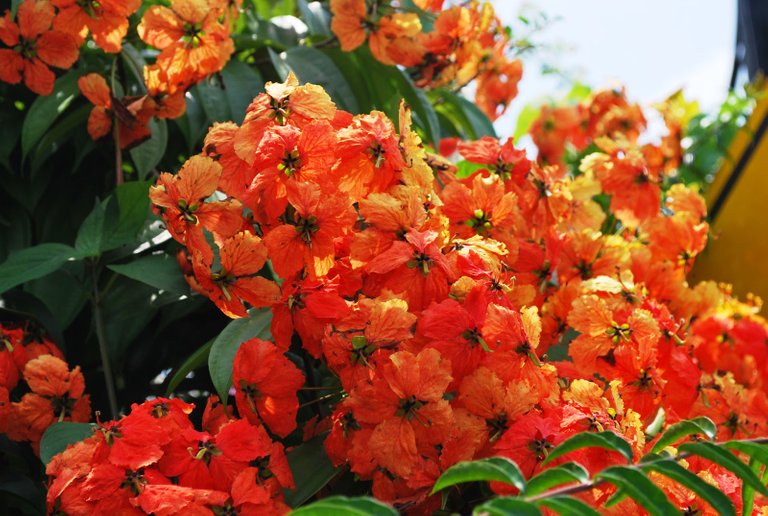
Beautiful flowers 😍✌️
The flowers are very fascinating and give the freshness of the soul to the beholder.
##Upvote/Resteem###
@ctrl-alt-nwo wow nice post wonderful garden disarming .great article & nice photography
Nice shot! Those flowers looks so beautiful! I noticed there's a lot of web also hahaha.
Wonderful flowers and great garden experiyance
Wow amazing & beautiful Red Bauhinia garden.
For your post propagation.
Upvote/Resteem
Well they do sure look really look beautiful and lovely as well !
Very beautiful and interesting petal structures! But the leaves are very interesting to me,they look like butterfly’s wings.
Such intense colours and dense bush!
Red Bauhinia Plants is wonderful. it is great garden experience . so really look flowers
@ctrl-alt-nwo
Red Bauhinia Flowers are awesome,thank you.